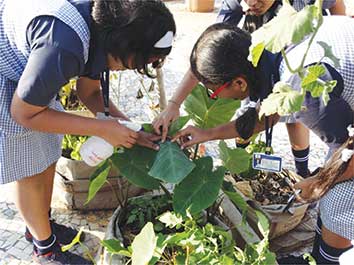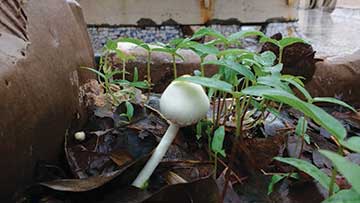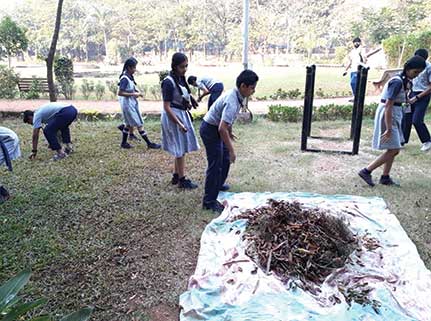Deborah Dutta
“The book just says sow the seed in the soil and the plant will grow. That doesn’t explain anything!” Arun* pointed to his motley group of saplings that he had managed to grow from the seeds distributed to his group. He was part of a group that was involved in setting up a rooftop garden in his school and I was facilitating the project. Starting from a barren terrace, the students soon realized the patience, effort, and skills involved in growing plants, almost none of which could ever be covered in their school textbooks. Barely half of Arun’s seeds germinated, then unexpectedly heavy rains damaged many of the fragile saplings. The few that survived were getting eaten by pests. Arun and his friends would observe their plants closely, ask us for solutions, and even began researching on the internet for ways to save their saplings. They realized that in terms of practical knowledge, the school support staff knew more than the teachers and flocked to the gardeners for advice. Their care and concern eventually paid off when a couple of saplings grew into healthy plants and bore them bhindi (okra) a few weeks later. None of their experiences could be found in a textbook, as evident in Arun’s simple but profound statement – ‘that doesn’t explain anything’.

The explanation here is not just about the information; rather, it is about appreciating and respecting the complexity of engaging with meaningful contexts that seem of consequence to them. Interestingly, the teachers involved in the project also found themselves more comfortable as co-learners rather than as authoritative figures needing to have ‘correct’ answers. The literal and educational openness provided by the rooftop farm allowed both students and teachers to explore questions and concerns that can rarely occur in classroom spaces. Questions like “Why is my bhindi plant getting infected?”, “Why are farmers paid so less for so much work?”, “Why is it important to save seeds?” naturally cropped up in sessions as their engagement helped them pay attention to things that went unnoticed earlier. Their shift in perception was evident in comments such as, “We never even touched plants this way earlier. I mean we play on the grass but not this way. To take care… this time we learnt how to grow the plant.”
Information is not knowledge
The fact that we are living in the midst of ecological crises is all too evident through the nearly steady stream of news, findings, and plethora of information. Terms like ‘global warming’, ‘climate change’, ‘ocean acidification’, etc., have been assimilated into everyday vocabulary, yet it would seem that increased information doesn’t seem to translate into impactful or sustained actions. On the contrary, there is a tendency to disengage from the clichéd doomsday scenarios that appear too far, too big, or too abstract to make sense of, let alone act on them. As author George Monbiot comments, ‘environment’ is an empty word because it doesn’t create any picture in the mind. There are no specific connections to build, no memories to recall, and no emotions to feel invested enough. Educators today need to translate the sterile information of ‘environment’ into stories and narratives of the ‘natural world’.
Rewilding education
While educational materials discuss the undesired futures and dire warnings in a lot of detail, articulating what children want is often neglected. Their wants and desires depend on the space and exposure provided to them to imagine their futures and priorities. A seminal study on factors contributing to ecological sensitivity by researcher Louise Chawla, based on extensive interviews with people working in the field of environment, showed that all of them traced their values to significant encounters with nature. Simply put, there is no substitute for direct and relevant experience with/in nature. Nature here doesn’t mean faraway, pristine mountains or wilderness. Even the most bustling cities consist of spaces that can allow nature to flourish, be it a park, a lake, a beach, or just the trees in the neighbourhood. Sustained immersion and exploration of these spaces create avenues for their subsequent care and conservation. Scholars call the process of ‘rewilding’ as rekindling a reciprocal relationship with nature, and nurturing an abiding love for the more-than-human world.
Students at the rooftop farm initially grimaced at the sight of compost, having never made it before. However, observing the compost over time and its effects on their beloved plants changed their perspective over time. Indifference gave way to curiosity and care. Towards the end of the project, one of the students commented, “Plants and trees were like this background green for me … now I can recognize them….” Recognition, after all, is the first step towards kinship. These forms of engagement are not meant to downplay the seriousness or global impacts of environmental issues. Rather, they help in grounding these issues by giving specific issues a context, history, and personal narrative1. The experience of making compost helped students understand the importance of dried leaves as mulch or decomposing matter. In cities, heaps of dried leaves are often burnt in the winter months or sent to the landfill. The students made efforts to collect such heaps from their neighbourhoods, and the ‘carbon cycle’ suddenly became a much more real example for them, where they could see how it could get recycled back into the soil or turn into carbon dioxide through activities like the burning of leaves. In another place, regular birding activity at a lake helped students monitor the effect of effluent discharge on the bird populations. Some of the most successful forms of civic protest or conservation projects have their origins in someone paying attention to a place.

Time to wonder and space to wander
Educating about the environment must acknowledge the importance of nature as a co-teacher in serious ways. This would mean stepping beyond the boundaries of a classroom and accepting the unpredictable outcomes of looking outside a window to watch birds2, climbing up a rooftop to grow a garden, or cleaning a local lake. Rather than simply learning from these contexts, students need to have the freedom to learn with and through them as well. Initially, the science teacher saw the rooftop garden as a nice space to teach students about plant anatomy. However, students were already observing much more than just the plant structure. They revelled at the sight of fungus growing overnight, ants lining up along mysterious routes in the garden, or seeing a tomato ripen on the plant. They were partaking in the relations and inter-dependencies constituting the garden itself. As co-teachers, we need to be attentive to moments when students attend to nature meaningfully. We need to acknowledge that nature is offering something beyond our ability to rationalize or teach. And when these moments arise, we need to provide time and space for the lessons to run their course. These radical shifts require an overhaul and rethinking of how we conceive the natural world. It is helpful to consider questions such as:
• What habits in my teaching place the natural world in the background?
• How can I invite the natural world to be present as a co-teacher in my practice?
• How can we learn about, with, through, and from members of the natural world?
• How might we be able to make space for other teaching voices (e.g.: plants, soils, birds, reptiles, trees, water) to be heard in their own ways?
Allowing for spontaneous encounters and lessons is by no means a passive activity meant to undermine the role of a teacher. On the contrary, moving away from the ‘safe spaces’ of textbook knowledge requires a willingness to embrace complex questions and navigate difficult scenarios with no correct responses. Learning to engage with uncertainty in generative ways becomes a community effort rather than a one-way transfer of information. It is worthwhile to ask oneself or peers questions such as:
• How can I empower learners to feel comfortable with the complexity of knowledge and its incomplete nature, instead of aiming for the easy, seemingly final, answer?
• What kind of support do we need for taking risks in making room for unknown, spontaneous, and unexpected to appear and be taken seriously in our educational work?

Photos courtesy: Deborah Dutta
In a book titled First Steps: Citizen Science in Ecology in India by Pankaj Sekhsaria and Naveen Thayyil, the authors outline 17 projects in India that have emerged through rigorous data collection and monitoring by ordinary citizens. In many cases, these observations have laid the ground for civil society organizations to push for policies or initiatives to safeguard the environment. Introducing students to such forms of participation can help provide powerful instances of meaningful engagement with the immediate environment. In addition, the tangibility of outcomes and narratives associated with it can help students understand the personal, social, and political dimensions of environmental stewardship.
Education has to squarely confront the fact that the way many humans currently exist on the planet needs changing, that this change is required at the cultural level3. Motivation for these changes can be nurtured through pedagogies that are actively aimed towards telling new stories of a world in which all beings can flourish. Moving away from the human-dominated narratives demands that we develop the capacities, skills, and empathy to listen to more than just human beings. We are fortunate, then, to have nature as a willing and patient teacher. During one of the sessions at the rooftop garden, students gathered to observe some soil layered with compost. Staring at it for a while, a student remarked, “The soil looks alive! Everything is moving there!” pointing to all the critters, ants, and earthworms wriggling in it. The recognition of something as living struck me as a profound statement, and one that we are prone to forgetting so easily. Yet, now is the time for remembering and affirming the possibilities of resilience, resistance, and restoration. Words can never stand for a world, so we need to literally walk the talk. Let a sparrow, a banyan tree, a pond or a mustard plant show you the way.
- See https://www.teacherplus.org/the-science-in-nature/ explaining how natural phenomena lends itself to inquiry
- See https://www.teacherplus.org/while-away-at-the-window/ for a note on birdwatching
- See https://www.teacherplus.org/teaching-for-a-resilient-tomorrow/ for a note on the need to develop resilience
References and resources
1) Some lesson plans for a place-based climate curriculum, designed by Palluyir Trust, Chennai. https://palluyirtrust.org/index.php/climate-curriculum/
2) SeasonWatch is an India-wide program that studies the changing seasons by monitoring the annual cycles of flowering, fruiting and leaf-flush of 130+ common trees. https://www.seasonwatch.in/
3) Zooniverse is the world’s largest and most popular platform for people-powered research. Anyone can get involved in a range of projects that feed into research. https://www.zooniverse.org/get-involved
4) Some learning modules on involving local contexts, designed under the Vigyan Pratibha project by Homi Bhabha Centre for Science Education: https://vigyanpratibha.in/index.php/learning-units/#8th-local-context
5) Wild Pedagogies: touchstones for re-negotiating education and the environment in the Anthropocene Cham, Switzerland, edited by B. Jickling, S. Blenkinsop, N. Timmerman and M. De Danann Sitka-Sage, Palgrave Macmillan, 2018
*Pseudonym
The author is a researcher working in the field of education and sustainability transitions, with a focus on community-based approaches such as urban farming. She enjoys collecting and sharing stories, seeds, and recipes. Find more about her literary rambles at
https://linktr.ee/deborahdutta. She can be reached at debbiebornfree@gmail.com.
